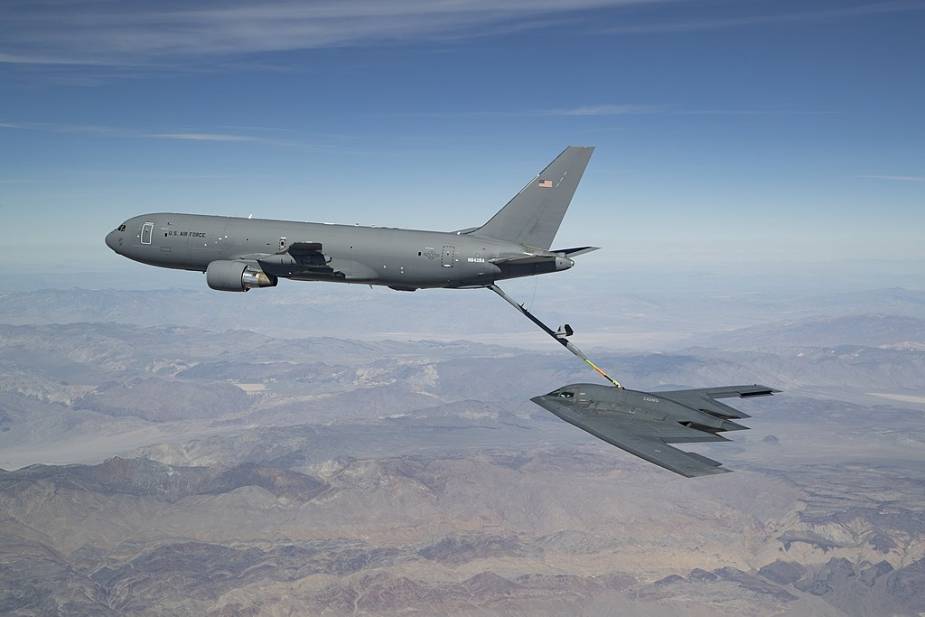Breaking news
Boeing to supply 15 additional KC-46A Pegasus air tankers to US Air Force.
The U.S. Department of Defense on January 27 announced that Boeing has been awarded a $2,255,625,408 modification (P00289) to previously awarded contract FA8625-11-C-6600 for KC-46A Air Force Production Lot 9 aircraft, subscriptions and licenses.
Follow Air Recognition on Google News at this link
 A Boeing KC-46A Pegasus connects with a B-2 Spirit over California, April 2019 (Picture source: Wikipedia/U.S. Air Force/Christian Turner)
A Boeing KC-46A Pegasus connects with a B-2 Spirit over California, April 2019 (Picture source: Wikipedia/U.S. Air Force/Christian Turner)
The contract modification provides for the exercise of an option for an additional quantity of 15 KC-46A aircraft, data, subscriptions and licenses being produced under the basic contract. Work will be performed in Seattle, Washington, and is expected to be completed by Aug. 31, 2026. Fiscal 2023 procurement funds in the amount of $2,255,625,408 are being obligated at the time of the award. Air Force Life Cycle Management Center, Wright-Patterson Air Force Base, Ohio, is the contracting activity.
The Boeing KC-46 Pegasus is an aerial refueling and strategic military transport aircraft developed by Boeing from its 767 jet airliner. In February 2011, the tanker was selected by the U.S. Air Force as the winner in the KC-X tanker competition to replace older Boeing KC-135 Stratotankers. The first aircraft was delivered to the Air Force in January 2019. The Air Force intends to procure 179 Pegasus aircraft by 2027.
Boeing KC-46 design
The KC-46 Pegasus is a variant of the Boeing 767 and is a widebody, low-wing cantilever monoplane with a conventional empennage featuring a single fin and rudder. It has a retractable tricycle landing gear and a hydraulic flight control system. The Pegasus is powered by two Pratt & Whitney PW4062 engines, one mounted under each wing. It has been described as combining "the 767-200ER's fuselage, with the 767-300F's wing, gear, cargo door and floor, with the 767-400ER digital flight deck and flaps". The KC-46 uses a similar Maneuvering Characteristics Augmentation System (MCAS) to that implicated in two 737 MAX crashes; in March 2019, the USAF began reviewing KC-46 training due to this feature. Unlike the 737, the KC-46's MCAS takes input from dual redundant angle of attack sensors and disengages with stick input by the pilot.
The flight deck has room for a crew of four with a forward crew compartment with seats for 15 crew members and in the rear fuselage either palletized passenger seating for 58, or 18 pallets in cargo configuration. The rear compartment can also be used in an aero-medical configuration for 54 patients (24 on litters). The KC-46A can carry 212,299 lb (96,297 kg) of fuel, 10 percent more than the KC-135, and 65,000 lb (29,000 kg) of cargo. Survivability is improved with infrared countermeasures and the aircraft has limited electronic warfare capabilities. It uses manual flight controls, allowing unrestricted maneuverability to avoid threats anywhere in the flight envelope.
At the rear of the aircraft is a fly-by-wire refueling boom supplemented by wing air refueling pods at each wingtip and a centerline drogue system under the rear fuselage so it can handle both types of refueling in one mission.
KC-46 Aerial Refueling Operator Station
Rather than using a single boom operator seated or prone at the tail looking out a window, the Aerial Refueling Operator Station (AROS) seats two operators at a video station at the front of the aircraft. They view images from a series of multi-spectral cameras distributed around the aircraft. AROS includes three main displays in front of each operator. The central 2D/3D display provides a view of the back of the aircraft for boom refueling operations. Boom operators can execute their mission in total darkness, with both aircraft blacked out. The hybrid 2D-3D system requires the use of stereoscopic glasses to get the full effect. The Remote Vision System (RVS) that feeds video to the AROS has been a source of problems including motion viewed in the RVS versus which can create a depth compression and curvature effect. [96] Blackouts and washouts on the video displays during refueling, caused by shadows or direct sunlight are a problem that will be fixed by the RVS 2.0 upgrade. RVS 2.0 is expected to alleviate problems in depth perception with new cameras and a full-color, high-definition screen. Boom operators with hundreds of hours of experience on older refuelers still prefer the KC-46, even with its current drawbacks.
The boom is furnished with a hydraulic relief valve system, similar to those on the KC-10 and KC-767 tankers, to relieve axial pressure in the event of excessive loads building up on the boom. In order to address the stiff boom issue, which keeps a KC-46 from refueling lightweight, thrust-limited receivers like the A-10, Boeing is replacing the current actuator with one using a pressure-flow PQ valve in the 2023 time frame. Near the front landing gear, there is a ladder that can be pulled down, providing quick ingress by the crew to the aircraft.


























